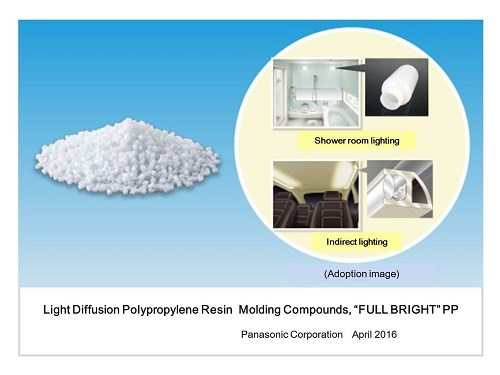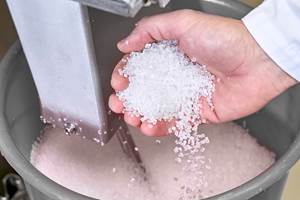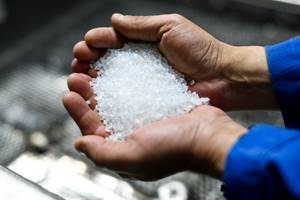More New LED Lighting Materials—LSRs, PPs and PCs
Wacker鈥檚 LSR encapsulants, Trinseo鈥檚 advanced PC, and Panasonic鈥檚 light diffusion PP are among the latest options.
Wacker’s LSR encapsulants, Trinseo’s advanced PC, and Panasonic’s light diffusion PP are among the latest options.
My third PT blog installment on interesting information that did not make it into New Materials Shine Bright in Growing LED Market, our upcoming June cover story, discusses new materials from Wacker Chemie, Trinseo, and Panasonic.
• Wacker Chemie, LSR Encapsulants for LEDs and Optical Components. Wacker’s new LSR compounds Lumisil 590 and 591 are highly transparent, addition-curing silicone elastomers with a refractive index of 1.53, which means they rank among the high-refractive-index (HRI) encapsulants. Such grades are particularly well suited for manufacturing highly-efficient LEDs. The HRI silicone protects the sensitive LED chip against mechanical influences and corrosive gases. At the same time, the silicone’s high refractive index enables optimum light efficiency.
Semiconductor chips used to generate light in LEDs have a high refractive index. To maximize the amount of light emitted by the LED chip that can pass through the encapsulation, the refractive index of the chip and encapsulant must be roughly the same value. Thanks to their refractive index of 1.53, Lumisil 590 and 591 reportedly make LEDs highly efficient. What’s more, the highly transparent silicones are almost completely transparent for light in the visible spectra range (400 to 700 nm) and reportedly do not yellow even when radiation is extremely intense. Transmission tests with Lumisil 590 show that a one-millimeter-thick layer lets over 91% of visible light through. These two materials are said to protect the LED chip reliably against environmental influences. Corrosive gases such as hydrogen sulfide can damage the LED chip and reduce its performance. Tests show that LED chips encapsulated with these materials are protected against such damage longer and have a prolonged life.
These new HRI silicones are said to be easy to process, heat-resistant and absolutely tack-free after curing. They also exhibit optimized flow and crosslinking characteristics. With a viscosity of the mix of 2000 and 2500 mPas respectively, they enable efficient, cost-effective processing. Both products are suitable for encapsulating the LED chip via contact-free dispensing processes, and they form cured rubber grades of varying hardness. With a hardness of Shore A 65, Lumisil 590 is relatively soft, whereas Lumisil 591 is formulated to be significantly harder at Shore D 40.
• Trinseo, Emerge PC 8330LT Advanced Resin & Tyril 905UV SAN. Trinseo began supporting the LED lighting market sector early on in the industry’s evolution and offers a broad portfolio of materials under the Caliber PC and Emerge Advance Resin brands, including: transparent, light diffusion, ignition resistant, and reflective grades used by several global OEMs for lenses, optics, diffusers, reflectors, and housings.
Late last year, it launched next-generation materials including Emerge PC 8330LT, an advanced PC that has been recognized for its ability to fill the need for a transparent, thin-gauge, flame-retardant plastic. It is UL94 rated V-0 at 1.0mm and 5VA at 2.5mm. Also, new is cost-effective acrylic alternative Tyril 905UV SAN resin.
• Panasonic Corp., Light Diffusion PP Molding Compounds. Panasonic has developed a light diffusion type PP molding compound which reportedly can extend the operating life of LEDs. Key applications include automotive interior lighting, outdoor sign boards, store lighting, and water-related lighting, as well as digital signage.
Branded Full Bright PP, the compounds are said to be an industry first in that, in addition to injection molding, they are applicable to injection stretch blow molding, enabling processors to form complex shapes with greater freedom based on individual customer applications. The new compounds are said to allow for the production of 0.02-9n. (0.5-mm) molding, which was previously unachievable; achieve less than 10% thickness accuracy by processing; and, unlike the company’s previously used conventional PP molding compound, they will not generate a hole when a product is blown to 0.02-in thickness.
The Full Bright PP compounds are also said to have overcome the weak light resistance of the conventional PP molding compounds and achieved excellent resistance to chemicals, contributing to extending the operating life of the LED lighting. Its UV resistance is as follows: under an environment of 90 C+ (UV radiation intensity of 400W mercury lamp-30cm distance), discoloration after 90 days of exposure (about 2000 hrs). Its 鈭咵 is 2.0 or below, which is equivalent to 10 years in outdoor environments; this compared to the company’s previous PP molding compound with a 鈭咵 of 17. Finally, the PP compounds’ low specific gravity contributes to lightweight design of LED lighting devices.
Read Part I, LSR Developments in LEDs for Automotive and Street Lighting
Read Part II, Plastic Heat Sinks for LEDs “Shine” for Two Lighting Component Manufacturers
Search for more of Wacker’s LSR and Trinseo’s PC and SAN offerings in PT’s materials database.

Related Content
Automotive Awards Highlight Emerging Technologies
Annual SPE Automotive event gives nods to several ‘firsts’ as well as sustainability.
Read MorePrices Bottom Out for Volume Resins?
Flat-to-down trajectory underway for fourth quarter for commodity resins.
Read MorePolymer Showdown — PPO vs. PA66: May the Best Material Win
Second in a series, an expert from plastics engineering consultancy The Madison Group pits leading thermoplastics against each other to see how they differ in processing characteristics, chemical resistance, thermal and mechanical performance, and more.
Read MorePrices for All Volume Resins Head Down at End of 2023
Flat-to-downward trajectory for at least this month.
Read MoreRead Next
Lead the Conversation, Change the Conversation
Coverage of single-use plastics can be both misleading and demoralizing. Here are 10 tips for changing the perception of the plastics industry at your company and in your community.
Read MorePeople 4.0 – How to Get Buy-In from Your Staff for Industry 4.0 Systems
Implementing a production monitoring system as the foundation of a ‘smart factory’ is about integrating people with new technology as much as it is about integrating machines and computers. Here are tips from a company that has gone through the process.
Read More












